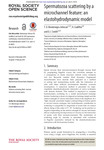| dc.contributor.author | Montenegro - Johnson, T. D. | en_US |
| dc.contributor.author | Gadêlha, H. | en_US |
| dc.contributor.author | Smith, D. J. | en_US |
| dc.date.accessioned | 2016-07-30T01:39:21Z | |
| dc.date.available | 2016-07-30T01:39:21Z | |
| dc.date.issued | 2015 | en_US |
| dc.identifier.other | HPU4160505 | en_US |
| dc.identifier.uri | https://lib.hpu.edu.vn/handle/123456789/22402 | en_US |
| dc.description.abstract | Sperm traverse their microenvironment through viscous fluid by propagating flagellar waves the waveform emerges as a consequence of elastic structure, internal active moments and low Reynolds number fluid dynamics. Engineered microchannels have recently been proposed as a method of sorting and manipulating motile cells the interaction of cells with these artificial environments therefore warrants investigation. A numerical method is presented for large-amplitude elastohydrodynamic interaction of active swimmers with domain features. | en_US |
| dc.format.extent | 14 p. | en_US |
| dc.format.mimetype | application/pdf | en_US |
| dc.language.iso | en | en_US |
| dc.subject | Structural biology and biophysics | en_US |
| dc.subject | Fluidmechanics | en_US |
| dc.subject | Biomechanics | en_US |
| dc.subject | Biophysics | en_US |
| dc.subject | Stokesian swimming | en_US |
| dc.subject | Fluid–structure interaction | en_US |
| dc.subject | Human sperm | en_US |
| dc.title | Spermatozoa scattering by a microchannel feature | en_US |
| dc.type | Article | en_US |
| dc.size | 1.17MB | en_US |
| dc.department | Education | en_US |

